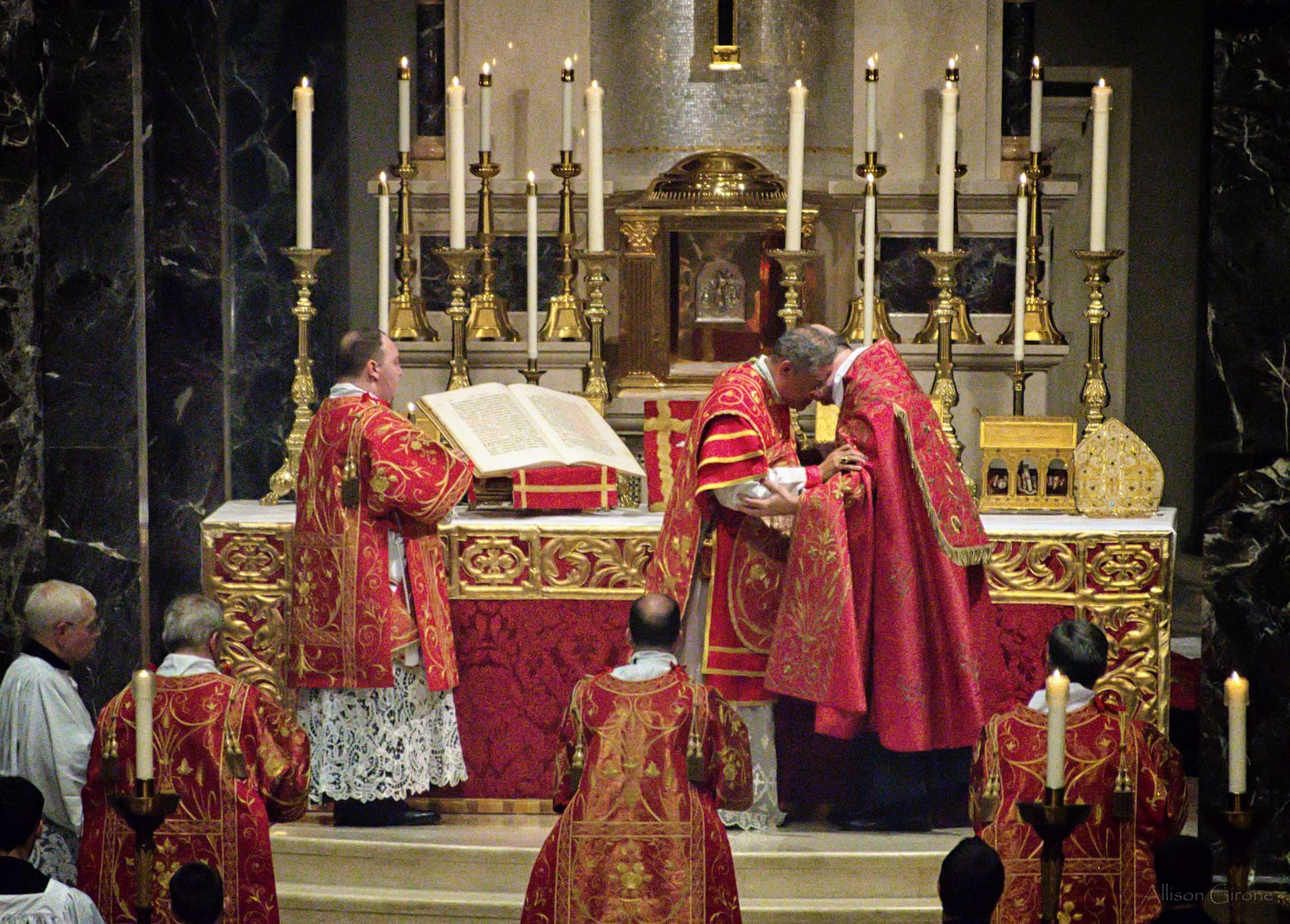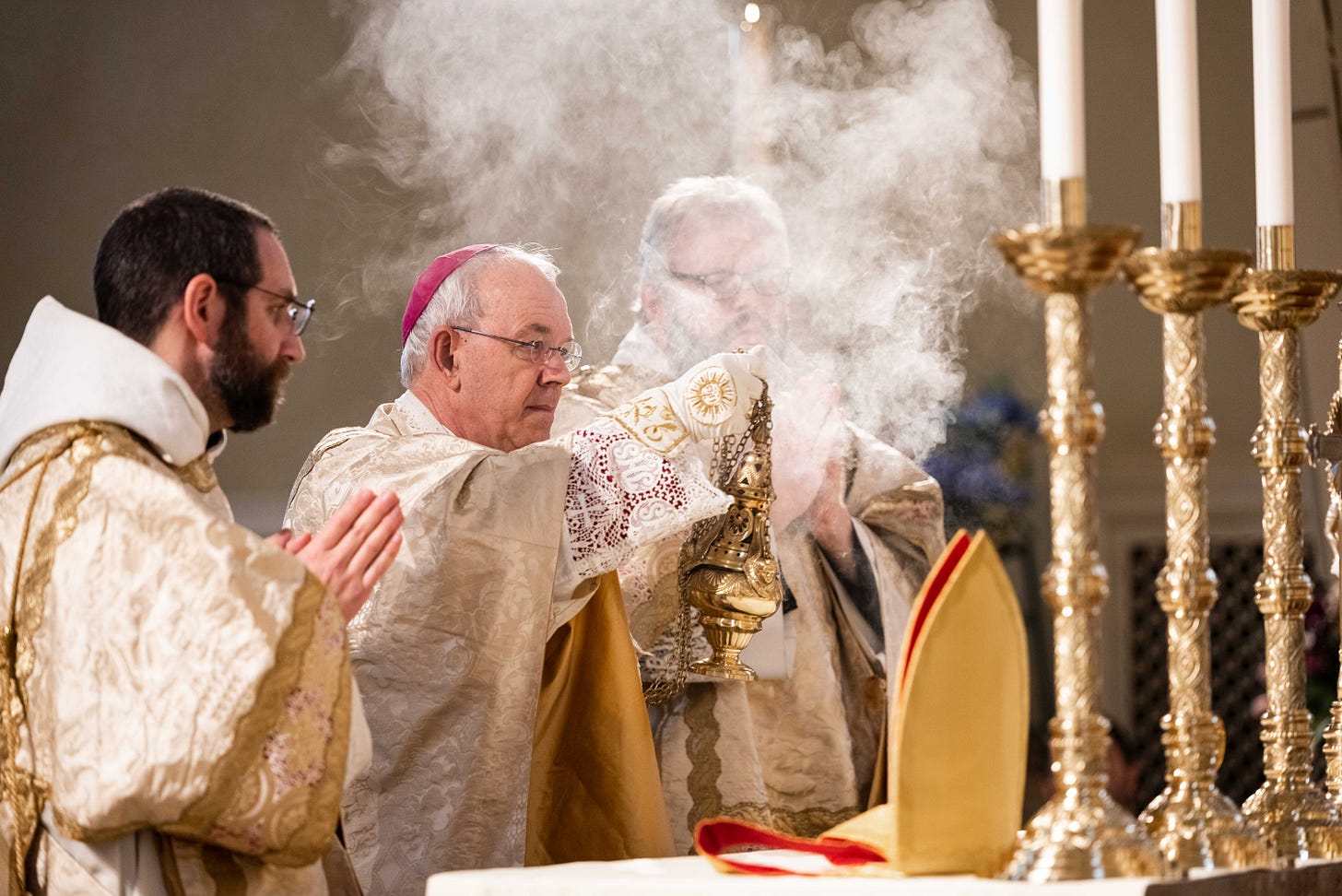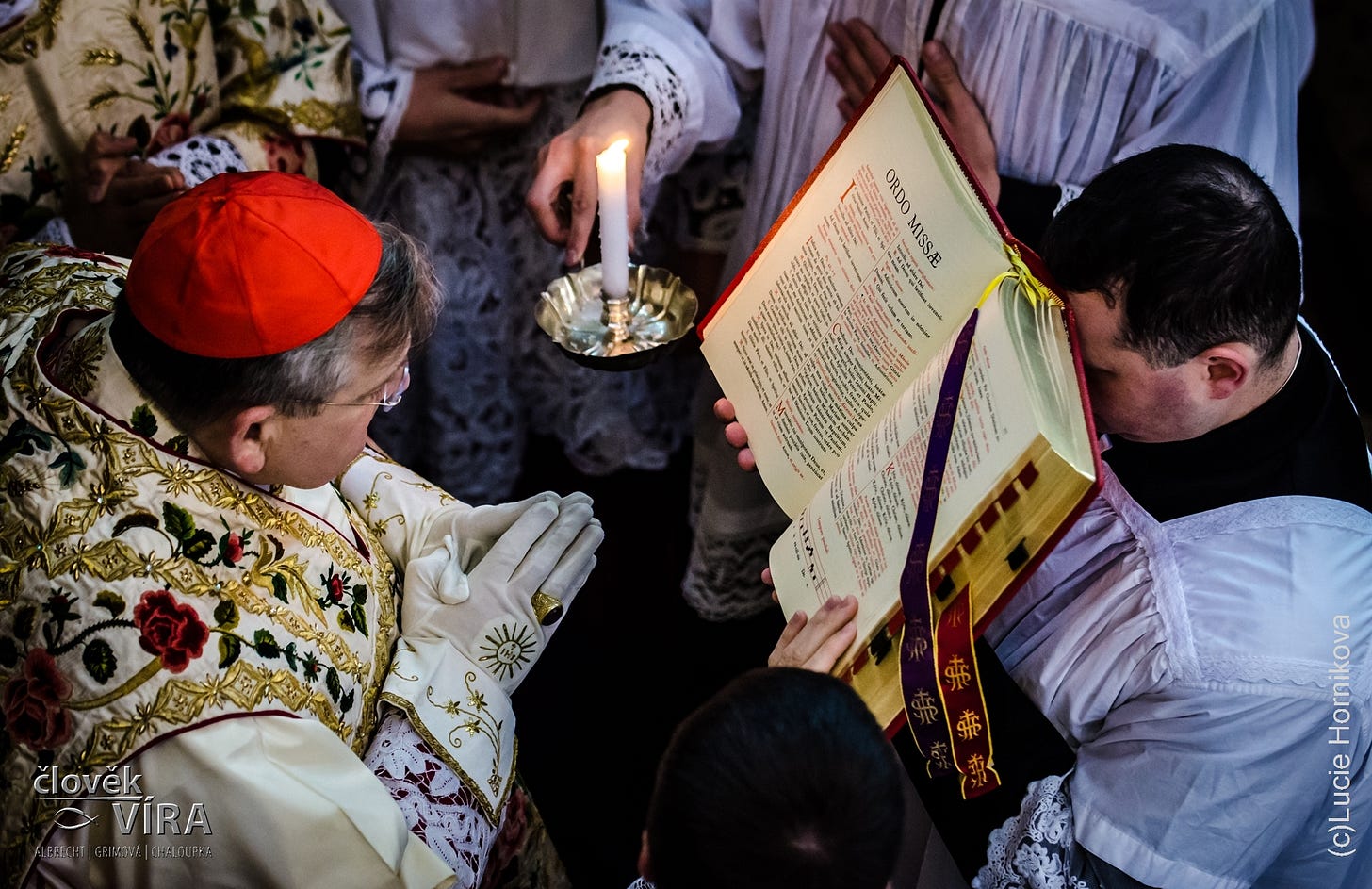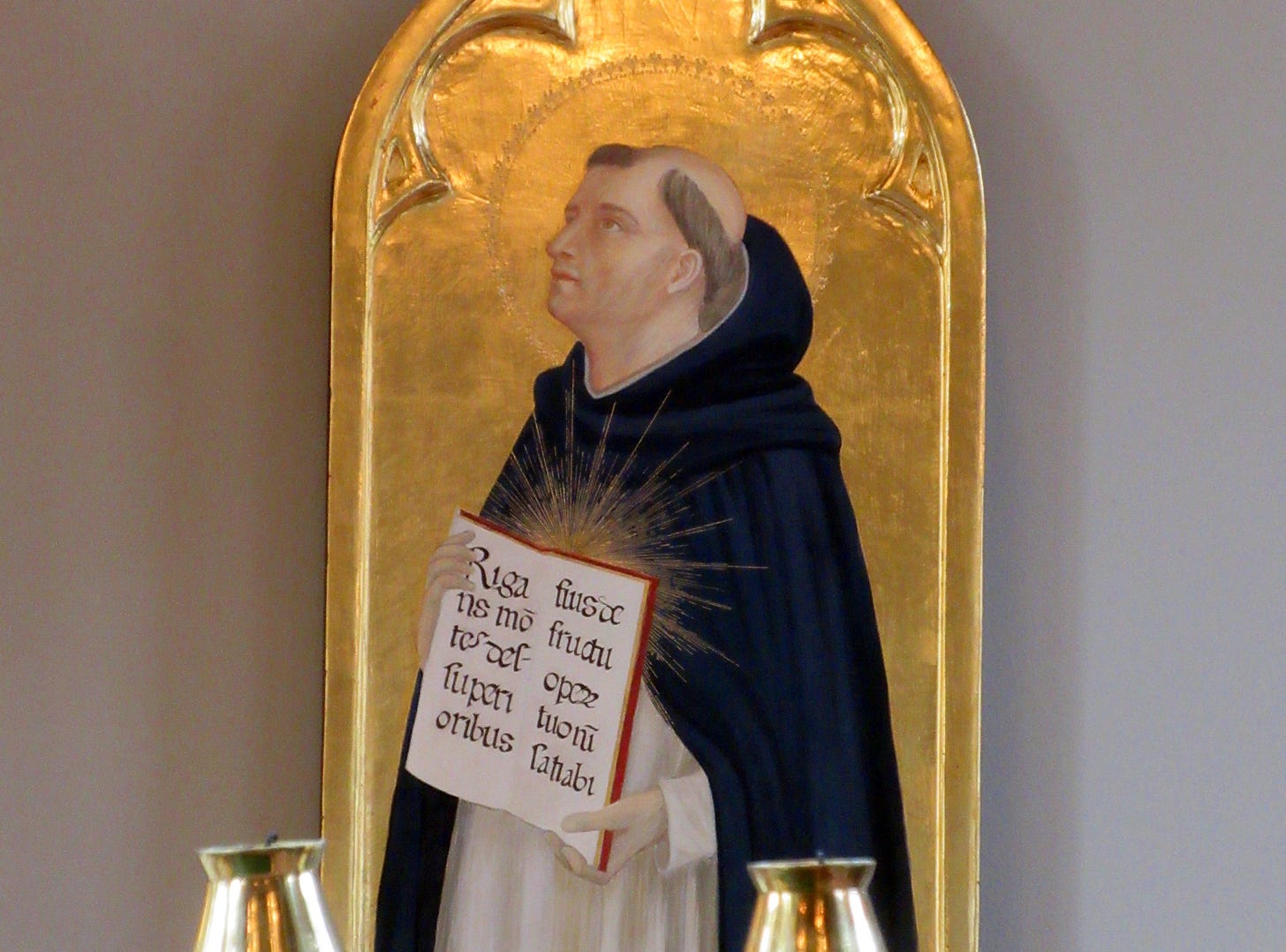Solemn Worship or Synodal Wrangling?
When will the Church's hierarchy put its best buskined foot forward? When will it show us a divine face? Dionysius and the Roman rite point the way.

The ordered cosmos and its “most sacred divine law”
In his inaugural lecture incepting as a Doctor of Theology at the University of Paris, the Dominican friar Thomas Aquinas spoke the following wonderful words:
The King and Lord of the heavens instituted this law from eternity: that the gifts of His Providence would come to lower things through mediators. Hence, Dionysius says, in On the Ecclesiastical Hierarchy: “the most sacred divine law is such that the middle things should by first things be led to his most divine light.” This law is found not only in spiritual things but also in bodily things. Hence Augustine says: “In the way that the most base and lowly are ruled by more subtle and powerful in rank, so also all bodies are ruled by the rational spirit of life.” We even see by our senses that rains flow from the highest clouds by which the mountains and rivers are watered, and proceed onward to nourish the earth and make it fruitful. In the same way, from the heights of divine wisdom the minds of teachers, signified by the mountains, are watered, by whose ministry the light of divine wisdom comes to the minds of those who hear them.1
Frequently, at a Solemn Mass, I am struck by the beauty of the hierarchical array of the ministers, especially after the Collect has been sung and the MC leads the subdeacon over to the center to chant the Epistle while the superior ministers (priest and deacon) go to the side, and the many servers calmly drift to their places. After the Epistle is chanted, the moving ceremony of the Gospel takes place, in which the deacon is blessed by the priest, who remains at the high altar while the deacon processes to his station, accompanied by ministers with candles and incense, to chant the Gospel northwards. When the Gospel is finished, the subdeacon carries the book back to the priest to be kissed. And so forth…
The liturgy bequeathed to us by tradition is full of such meaningful beauty. The ceremonies speak to us of divine mysteries too deep for words. Our words can approach, surround, and caress those mysteries, but all the while we sense their inadequacy. As is often said: “If we could describe music in words, there’d be no need for it.” Liturgy is like vocal music in that sense, conveying not only a text but also something in a language beyond language.
Ceremonies like silver, fire-tried, purged from earth, seven-times refined
For instance, the stylized “kiss of peace” in the old rite conveys more than a learned disquisition could do, and far more effectively. I once described the “the solemn and hieratic ‘giving of the peace’ during the Agnus Dei” thus:
the priest in a simple but noble gesture giving peace to the deacon, the deacon in turn to the subdeacon, the subdeacon to the seminarian at the side, while the Schola chanted dona nobis pacem and the priest prayed Domine Jesu Christe, qui dixistis apostolis tuis, pacem relinquo vobis, pacem meam do vobis: “O Lord Jesus Christ, who didst say to Thine apostles, peace I leave with you, my peace I give unto you.” It was clear that this peace streamed forth from the Lord, and through His ministers; it flowed from the altar outwards, as in Ezekiel’s vision of the water flowing from the temple. Watching how the peace was given—the symbolic announcement of fraternal union among the ministers at the altar, as though Christ’s peace were being both “acted out” in a drama and enacted in reality—it struck me that a congregation who witnessed it would be in a position to obtain a vivid insight into the objective nature of Christian charity and fraternal harmony, with its necessary link to Christ (=the altar), His Holy Sacrifice, and Himself in the Holy Eucharist.
What details abound in the “forest of symbols” that the Mass is!
I noticed too the manner in which the priest and deacon, hierarchically standing at the altar, turned to face the people at the end, the priest to sing Dominus vobiscum and the deacon to sing Ite missa est, while the subdeacon remained with his back to the people and his face hidden, giving a striking image of the Blessed Trinity—the Father and Son manifesting themselves through each other (the Father as Dominus, as in the prayer for the church’s guardian angel at the very beginning: Domine sancte Pater, omnipotens aeterne Deus; the Son as the High Priest who offers the sacrifice: the Ite, Missa est chanted by the deacon), while the Holy Spirit, though present, remains elusive: as St. Thomas explains, we cannot give a “proper” name to the Holy Spirit, as we can to the Father and the Son.2
The entire Solemn Mass is filled with such ceremonies of subordination, assistance, communication, association, bestowal and reception. To borrow a phrase from the psalmist, the ceremonies of the great Western rites are like “silver tried by fire, purged from the earth, refined seven times” (cf. Ps 11:7 DRA): they have passed through the fire of the Holy Spirit, their earthly dross has been purged, their execution refined to perfection.
Such observations prompted me to exclaim:
Could there be anything more beautiful and at the same time more instructive than every gesture, every word, every chant, of the ancient Roman rite? When properly done, it is absolutely the equal of the most elaborate and richly-texted Eastern liturgy. The main reason Westerners feel “Byzantine envy” is that they so seldom experience their own rite in its fullness. Each has strengths peculiar to itself: the Eastern liturgy excels in the poetic fervor and doctrinal content of its hymns, while the Western liturgy excels in the potent conciseness of its prayers and in the dignity, solemnity, order, and peacefulness of its ceremonies.

Displaying the inward reality of the Church’s human hierarchy
“For us [men on earth],” says Dionysius the Areopagite, “it is by way of the perceptible images that we are uplifted as far as we can be to the contemplation of what is divine…. our own hierarchy is itself symbolical and adapted to what we are.”3
The liturgy, one might say, puts into visual form—almost into the form of a religious dance—the spiritual actions of intellectual creatures: of the angels, among whom the higher both look more intently to God and illuminate those inferior to them; of the saints in heaven who intercede for the militant on earth; of the souls in purgatory who rely on our prayers even as they pray for us; of the Church’s hierarchy on earth, where the pontiff is served by the priest, the priest by the deacon, the deacon by the subdeacon, the subdeacon by the minor ministers, with the choir and the people also caught up, in their own ways, in the selfsame action and reception.
What we see here is the ecclesiastical hierarchy “put on display” but also actualized and energized in its highest purpose: the worship of God and the sanctification of His faithful ones.
(An aside: We do still agree, don’t we, that the worship and love of God for His own sake is our highest purpose—the soul’s, the Church’s, the priest’s, the hierarchy’s? Because if we don’t agree about that, I’m afraid we have a rather colossal problem on our hands.)
In a very important sense, the hierarchy exists chiefly for this aesthetic and symbolic purpose: not primarily to teach or govern, to issue letters or laws or policies, much less bureaucratic paperwork about the social causes du jour, and still less to indulge in vastly expensive, time-consuming synodal processes (libera nos, Domine); but to exemplify the hierarchy within the Blessed Trinity, the hierarchy of angels and saints in the King’s heavenly court, the graceful order of the celestial city of Jerusalem. When I see the solemn Mass, my heart soars with appreciation of hierarchy. That is when it ceases altogether to feel like a top-down imposition of blathering, bezzling, banking bureaucrats and feels, as it should, like the refraction, into a spectrum of rank, order, and purpose, of a single bright ray of divine splendor shining from the triune source of light.

The right and the wrong kind of pontificating
I have spent a fair amount of time in the company of many bishops and even a few cardinals. Some of them have been amiable, others unpleasant; some highly intelligent and literate, others not so much; some rigidly orthodox, earnest seekers of the kingdom of God (as they should be), others morally flexible and political, exuding cowardice, ambition, or, worst of all, progressivism.
But I have been moved to a profound love of a bishop only when I have seen him “pontificating,” that is, celebrating a solemn (traditional) Roman liturgy in which his unique assimilation to Christ the Eternal High Priest is vividly clear, overpowering his personality, cloaking him in apostolic, ecclesial, heavenly grandeur symbolized by layer upon layer of vestments. (In the old rite, the bishop has to don every type of vestment, one atop the other—cassock, alb, tunicle, dalmatic, chasuble—to show that he has the fullness of all orders.4)
When I say “love,” I don’t mean the sort of blanket charity that we’re supposed to have for every member of the Body of Christ; I mean more specifically a grateful admiration of who and what he is, and a real willing of his good. That is what a solemn pontifical liturgy brings out for me: it helps me to renew my faith in this man as a successor of the apostles, one who is carrying on their primary task, which is not to wait on tables, that is, busy himself with more worldly affairs, but to remain attached to the Word of God (cf. Acts 6:2)—which is done above all through the glorification of the Word-made-flesh in the Eucharistic sacrifice.5
How sad it is, then, even tragically ironic, that the hierarchy since the time of the Second Vatican Council has by and large given up its most beautiful and splendid task—namely, of lifting up, by means of a richly-stratified, office-abundant liturgy, the edge of the veil of the world to come—and has identified itself instead with its still-important but less theocentric tasks of teaching and governing (or whatever verb could be used for endless staff meetings and synodal gatherings) so that today when we hear or think of “hierarchy” or even “clergy” we may not intuitively think about God or heaven or beauty, but about Vatican politics, Roman dicasteries, diocesan chanceries, local pastors’ turf wars… the too-often worldly and anything but theocentric agendas that dominate clerical bodies, which have turned themselves into something like churchly regulatory agencies.
Athanasius contra mundum ecclesiae
No one has more courageously and luminously called out the spiritually desiccating bureaucratization of the Church than Bishop Athanasius Schneider, who, incidentally, also celebrates more traditional pontifical Masses than any other prelate I am aware of, with the possible exception of Cardinal Burke.
Every time I have seen Bishop Schneider, he is either praying and liturgizing, preparing to pray, or writing on and explaining prayer and worship to the people. His heart is a heart for worship, and even his doctrine tastes of bread and wine and smells like incense. What a marvelous example of putting the first table of the law before the second table (as we must do in order to live justly), and putting both these tables ahead of waiting on tables—seeking first the kingdom of God and His righteousness, so that all else may be added in their rightful place!
In his masterful book-length interview Christus Vincit, Bishop Schneider says:
To be honest, I am bored with episcopal meetings and synods. As much as I love my brother bishops and love to meet them, this method of continual synods and assemblies, which are often dominated by frenetic activity, are influenced by the spirit of Pelagianism and Modernism. They are often sterile and give the impression of an enormous show of clerical vanity....
It would be far more beneficial—personally, psychologically, pastorally, and ecclesiastically—to meet with the simple Catholic faithful. We bishops would do better to meet young people and young families with children who are thirsting for the beauty of God, the beauty of Catholic truth and life, and for the beauty of Catholic liturgy....
I am not against synods or other episcopal assemblies as such, provided they happen infrequently, are of short duration, have minimal bureaucracy and transparent and fair rules of procedure, and above all, guarantee and safeguard the integrity of doctrine and discipline in the discussion papers and in the final document....
The continuous meetings and assemblies of bishops: they are spending so much money, it’s incredible. If we would reduce drastically the frequency of these meetings, we could give millions of dollars every year to the poor around the world. To me, this is a sin that churchmen are committing today....
Yes, the number of meetings is increasing. For me it is a sign: when there is a lack of faith and desire for the supernatural, a lack of love for prayer, for works of penance and direct evangelization, then the bishops and those who govern in the Holy See cast themselves into frenetic activities: synods, documents, continuous events.6
I suppose this is a way of saying, with Fr. Z (or rather, with the elderly bishop he’s fond of quoting): “less chatter, more processions.”
The episcopacy reborn in Eucharistic love
To put it in the terms of my earlier remarks: More solemn hierarchical chanted Latin liturgy, and less of pastoral programs, synods, interim documents, diktats and fatwas. This would do more than anything else to heal the broken relationships between past and present, between clergy and faithful, between older and younger generations. Turn us all toward God, and we will find again the deepest meaning of hierarchy or “sacred principle.” We will find the gladsome wherewithal to follow our shepherds when we see them following Christ to the Cross, when they are not only facing but living ad orientem, when they are ascending with Him as an odor of sweetness to the Father.
If this were done—if it were done consistently and well—then the words of Dionysius the Areopagite would be verified: “Because of this inspired, hierarchical harmony, each one is able to have as great as possible a share in Him who is truly beautiful, wise, and good.”7 It might even be said that the synaxis or gathering for worship “forges a divine unity out of the divisions within us. It grants us communion and union with the One.”8
It is as if the Church’s hierarchy has chosen to downplay or demote its chief glory and to insist on presenting itself primarily as a structure of power over people. The hierarchy’s abandonment of its primary duty, the solemn cultus of the thrice-holy God in the divine liturgy; its absorption of secular concerns—day-to-day politics, economics, education, immigration, and the natural environment—that are proper to the Catholic laity, who must navigate them according to right principles; and its fixation on governing rather than worshiping and sanctifying: this inversion or subversion of identity is at the root of the crisis in the Church.
That crisis will be healed when priorities are correctly aligned and all the world may see, in the universal currency of time and effort lavishly expended at the foot of His throne, that God is the first love of those who claim to speak on His behalf.
Weekly Roundup
Other articles and videos of mine that you may find of interest:
My Monday article this week at New Liturgical Movement is “The Carthusian’s Story of John Smith and the King: ‘Begin low, and go slow, rise high and take fire’” (May 15, 2023).
My Wednesday article at OnePeterFive this week is “Custom and the Force of Law” (May 17, 2023).
On Friday, May 12, I announced the publication of a collection of writings by nine authors: Illusions of Reform: Responses to Cavadini, Healy, and Weinandy in Defense of the Traditional Mass and the Faithful Who Attend It. You can read more about it at NLM or at Rorate. Or you can watch a very entertaining and informative 3-minute promo video.
The opening of Rigans montes (“Watering the mountains”), the lecture Aquinas gave in 1256 upon receiving his license to teach at the University of Paris. The text is found in St. Thomas Aquinas, Commentary on Psalms; Rigans Montes; Hic Est Liber (Steubenville, OH: Emmaus Academic, 2021), 1. In the chapel of the seminary in Charlotte, North Carolina, behind the altar stands an icon of St. Thomas, holding a book open with the words of this lecture:
Patrick Kornmeyer, in an article I love to cite, speaks of “exult[ing] in the symmetrical perfection of priest, deacon, and subdeacon moving in perfect harmony from the Introit at the Epistle side of the altar to the Gloria at the middle, seeing in it a glimpse of single yet triune action.”
Ecclesiastical Hierarchy, chapter 1, 373B and 377A.
See Gregory DiPippo, “The Pontifical Vesting Prayers of the Usus Antiquior,” New Liturgical Movement, December 29, 2011; Christopher Owens, “Pontifical Vesture: Putting on the Full Armor of God (Guest Post),” New Liturgical Movement, November 4, 2014.
Acts 6:2 says literally: “It is not right/pleasing/fitting that we should leave/forsake/abandon the Logos of Theos to wait upon tables.”
Christus Vincit (Brooklyn: Angelico Press, 2020), 113–14, 116.
Ecclesiastical Hierarchy, chapter 1, 373A.
Ibid., chapter 3, 424D.








This is a splendid article. Volumes could be written about all the points you presented. It is beyond belief what has been eliminated under the banner and guise of "noble simplicity" Maranatha
I hope you may some day be appointed to the very necessary but still to be to be created office of Inspector Liturgicus Maximus totius mundi Latini!
An excellent and liturgically speaking life-saving article. Thank you very much!
‘No one has more courageously and luminously called out the spiritually dessicating bureaucratization of the Church than Bishop Athanasius Schneider[ …].’
What a gift of the Holy Ghost! (This is the first time that I have seen him in this light.)
Suggestion from personal experience: in order to get ‹desiccate› (q. v. infra) right, think like me of ‹siccus›.